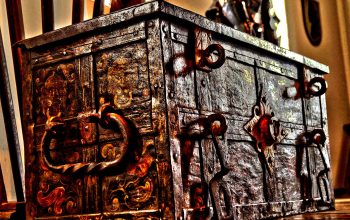Recently in my home campaign the players have been exploring Stonehell, Michael Curtis’ mega-dungeon which I’ve pre-empted into my own world. I don’t know how much of the campaign will be occupied with the exploration of this truly massive dungeon, but so far it’s been fun.
We had a rather hilarious encounter with a green slime (the paladin now has no pants), but the humor aside I realized I really liked the lead-up to this encounter. I’m not sure if Curtis planned it this way, I certainly didn’t notice the connections myself until we were playing it, but if not it’s a really lovely bit of serendipity and if so I think he’s certainly to be commended for the work. But I’m getting ahead of myself, let me describe the situation. You can follow along if you like, the rooms in question are rooms 2-4 in section 1A which is included in the free preview of Stonehell.
The party comes through the rooms in reverse order, starting with room 4, which is burned to a crisp. Soot on the walls, charred furniture, smell of smoke — actually I think that’s the entire description of the room Curtis gives right there. The next room is an old feast hall, filled with cracked and broken furniture, torn apart tapestries, etc. So far, nothing very exciting, just so much set dressing. Finally, the last room is the kitchen, which contains not only broken up crockery and the like, but also an old sink with a pump. Naturally the players decide to work the pump, and out of this pump comes the green slime.
So what do the players do? What any player who knows his D&D lore does, he gets some fires going. They light up a couple torches, but they know they need more. They run back into the previous room and start breaking up the furniture and tearing down what’s left of the tapestries to make some torches to fight off the slime. That’s when it hits me. Holy crap, someone’s done this before!
Think of it, many years ago, an earlier group enters the same rooms. Maybe they even start in the kitchen, which isn’t as destroyed as it looks. But sure enough there’s green slime there, maybe even more than our current group encounters. They realize they’re in trouble. In the scuffle to escape the room, they knock over tables and chairs, breaking up the nice stoneware. They flee through the feast hall, and realizing they’ll need torches, they smash up the nice furniture and tear down some of the tapestries. But the slime is still coming at them, so they fall back further. In the third room is where they make their stand. What was in that room? Who knows, they torched it. The slime was everywhere and they burned the slime completely. All that remains is some soot, ash, and a smell of smoke. The party evaded their doom this time. Or maybe one of them didn’t, and the slime he turned into is now in the drain of the kitchen sink.
Maybe that’s not what Curtis had in mind, I don’t really know. I like to think he did, because it’s just so darn clever. It’s like when a party enters a cave full of scared looking statues, but much more subtle. With the statues, everyone is on the look-out for the basilisk right away. In this case, even I didn’t see any connection when reading the descriptions — only the players’ actions in the fight gave it away.
Now I’m wondering how I can channel some of this myself for my own future work. Perhaps some piles of glass and wet spots on the floor where a past party chucked some vials of holy water. Maybe some old dried up wolfsbane sprinkled about on the floor. Or a spattering of sand and some blood stains where a magic-user once cast sleep and then slit his enemies’ throats. Or perhaps the most subtle of all: a door iron spiked shut.



Showing what somebody did before is definitely a nice way to demonstrate the “right” solution, if that’s what you’ve got in mind for an encounter.
As for me, I also find myself wondering if there’s a connection between those rooms and the “blast room” where we found Grut.